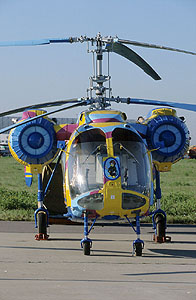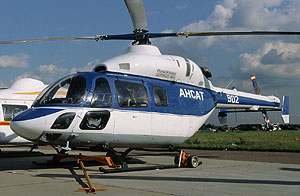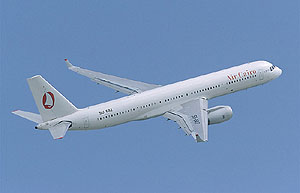 From
Russia with love
From
Russia with love
Hugo Mambour/AviaScribe was stirred, if not shaken, at MAKS 2001.
Part two: For your eyes only...
Krafty Kamovs
At Zhukovskiy an anonymous Ka-50 could be found, although after a search - it was hidden by the local topography, far away at the end of the static line. This particular machine had flown actual combat operations, photographs published in Russian magazines proving it. Derivatives of the Ka-50 included the side-by-side twin-seater battlefield command-and-control Ka-52 and a mockup of the tandem twin-seater Ka-50-2 'Erdogan', which was originally designed in cooperation with Israel for Turkey (the possible Russian development of that version will be known as the Ka-54).
 The
unavoidable Ka-31A1 of the Moscow fire
department was back again, but a new prominent fire hose was mounted under
its nose. This equipment is designed to combat fires in such buildings
as towers and this is obviously a consequence of the Ostankino TV tower
fire two years ago. The Ministry of Emergency Situations (MChS) is interested
in a huge number of search and rescue variants of the Ka-226, but only
five examples have been ordered to date. The Ka-226 displayed during MAKS
was nevertheless adorned with a military colour scheme, representing a
transport variant able to carry eight commandos and their equipment in
the pod cabin.
The
unavoidable Ka-31A1 of the Moscow fire
department was back again, but a new prominent fire hose was mounted under
its nose. This equipment is designed to combat fires in such buildings
as towers and this is obviously a consequence of the Ostankino TV tower
fire two years ago. The Ministry of Emergency Situations (MChS) is interested
in a huge number of search and rescue variants of the Ka-226, but only
five examples have been ordered to date. The Ka-226 displayed during MAKS
was nevertheless adorned with a military colour scheme, representing a
transport variant able to carry eight commandos and their equipment in
the pod cabin.
Kamov had
put on static display the possible future successor of the Mi-8, the Ka-60
(production should start this year at Lukhovitsy), but Kazan Helicopter
Plant (KVZ) and Ulan-Ude Aircraft Plant (UUAZ), in collaboration with
the Mil Moscow Helicopter Plant (MVZ, named after Mil), had brought their
own interpretation of the Hip replacement, i.e. new and/or upgraded Mi-8!
The Mi-8MTV-5/Mi-17MD (KVZ) is an improved
day/night combat version of the Mi-8MTV, able to shoot ATGM missiles and
equipped with a rear-loading ramp for light vehicles or artillery pieces,
whereas the Mi-8AMTSh/Mi-171Sh is the
same interpretation - although without rear loading ramp - by MVZ. Besides
the  dedicated
(night) attack helicopter Mi-28NE (NE
is just the export designation of the unique Mi-28N), no less than three
upgraded variants of the Mi-24V and
P were on display. Two versions were equipped with a GOES turret, whereas
the most elaborated model, designated as Mi-24PN
(a modified Mi-24P) and featuring a Zarevo electro-optical turret (Zenith-built)
in the nose had also been modified with the same main and tail rotors
as the Mi-28. Some Russian Army Aviation Mi-24P and Vs will be upgraded
to the same level.
dedicated
(night) attack helicopter Mi-28NE (NE
is just the export designation of the unique Mi-28N), no less than three
upgraded variants of the Mi-24V and
P were on display. Two versions were equipped with a GOES turret, whereas
the most elaborated model, designated as Mi-24PN
(a modified Mi-24P) and featuring a Zarevo electro-optical turret (Zenith-built)
in the nose had also been modified with the same main and tail rotors
as the Mi-28. Some Russian Army Aviation Mi-24P and Vs will be upgraded
to the same level.
Kazan Helicopters had also brought its Ansat design to Moscow. The Ansat is the first helicopter to have been developed at Kazan since the break up of Soviet Union and is motorised by Pratt & Whitney Canada PW-206 engines, license-built by Klimov.
Test & research
As always, some local test, research or support aircraft of the Russian Flight Research Institute (Lyotno-issledovatels'kiy institut or LII for short) could be found in the static display. Two of its aircraft, a Tu-154M and a Su-27LL, had received a new customized colour scheme. The latter aircraft, which was equipped with a side stick several years ago, is at the present time used to test in-flight reprogrammable digital fly-by-wire controls as well as in-flight reprogrammable head-down and head-up displays.
A Su-24M was shown with a particular ventral pod. This aircraft is used to check the impact of jet engines on the troposphere (see part one for pictures of test aircraft described here). A handful of Il-76SKIP telemetry aircraft are based in Zhukovskiy but some of them have not been flown for several years now as they are still wearing Soviet era codes. Older aircraft can be found in different areas of the vast airbase, like the last Tu-16 engine tested, which is not flying anymore. More conventional aircraft are also based at Zhukovskiy, like the three Tupolev type bombers on strength with the Long-Range Aviation. Tu-22M3, Tu-95MS and Tu-160 used to take part in the flying display until 1995. Unfortunately, it has never been repeated since then and except the Backfire they had even disappeared from the static display area, but they were at least back on the ground for MAKS 2001.
 Six
Tu-160 'Blackjacks' are based in Zhukovskiy, including the prototypes.
Unfortunately, only two of them are currently airworthy, comprising the
third prototype, which always used to take part in the flying display
in the past. More heavyweights included traditional Russian and now Ukrainian
transport aircraft. The giant An-225
flew one time together with the An-70.
The An-225 is now involved in commercial cargo flights and a second example
of the 'Mriya' could be completed if the current operations prove to be
viable. The An-70 program seems now to be going better after the crash
of the last remaining prototype at Omsk on 21 February 2001 as serial
production is now scheduled to take place at Omsk. Preliminary agreements
for serial production of the An-70 at the Polet (pronounce Palyot, flight)
factory were signed in December 2001. However, new engines will be fitted
to the aircraft as the experimental D-27s currently mounted do not satisfy
the military. Around 150 An-70s will be built between 2007 and 2009 to
replace the An-26, An-12 and some Il-76s of the VVS. Around 60 aircraft
should also be built for the Ukrainian VPS.
Six
Tu-160 'Blackjacks' are based in Zhukovskiy, including the prototypes.
Unfortunately, only two of them are currently airworthy, comprising the
third prototype, which always used to take part in the flying display
in the past. More heavyweights included traditional Russian and now Ukrainian
transport aircraft. The giant An-225
flew one time together with the An-70.
The An-225 is now involved in commercial cargo flights and a second example
of the 'Mriya' could be completed if the current operations prove to be
viable. The An-70 program seems now to be going better after the crash
of the last remaining prototype at Omsk on 21 February 2001 as serial
production is now scheduled to take place at Omsk. Preliminary agreements
for serial production of the An-70 at the Polet (pronounce Palyot, flight)
factory were signed in December 2001. However, new engines will be fitted
to the aircraft as the experimental D-27s currently mounted do not satisfy
the military. Around 150 An-70s will be built between 2007 and 2009 to
replace the An-26, An-12 and some Il-76s of the VVS. Around 60 aircraft
should also be built for the Ukrainian VPS.
 Other
transport and airliner aircraft ranged from the An-3T
biplane to the Tu-334 as well as the
Tu-154M, Tu-204, the Il-114,
the An-140 and the rejuvenated An-30.
The three current Beriev amphibious designs, Be-103, Be-200 and Be-12P
firefighter took part in the flying programme, the latter being the
most impressive as it collected water from the Moskova, just behind the
control tower!
Other
transport and airliner aircraft ranged from the An-3T
biplane to the Tu-334 as well as the
Tu-154M, Tu-204, the Il-114,
the An-140 and the rejuvenated An-30.
The three current Beriev amphibious designs, Be-103, Be-200 and Be-12P
firefighter took part in the flying programme, the latter being the
most impressive as it collected water from the Moskova, just behind the
control tower!